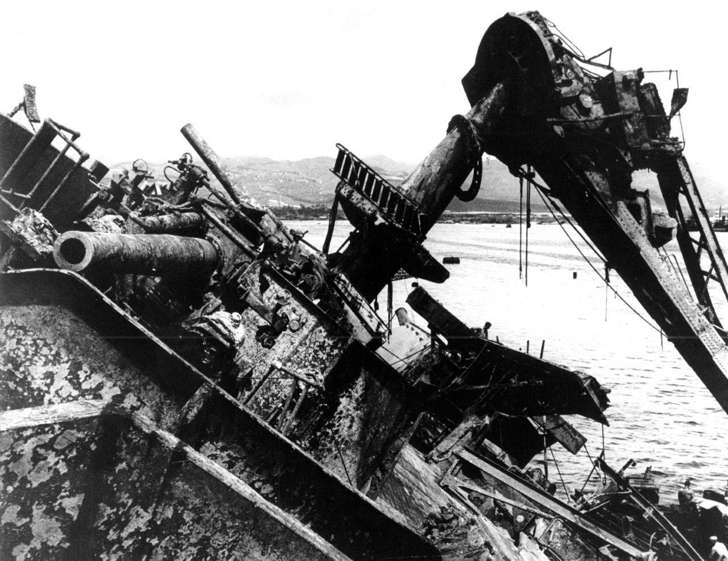You are using an out of date browser. It may not display this or other websites correctly.
You should upgrade or use an alternative browser.
You should upgrade or use an alternative browser.
Remember Pearl Harbor
- Thread starter old mossy
- Start date
S
SHOOTER13
Guest
S
SHOOTER13
Guest
OFFUTT AIR FORCE BASE, Neb. — Inside an old aircraft factory here, behind the glass windows of a pristine laboratory, the lost crew of the USS Oklahoma rests on special tables covered in black foam.
Their bones are brown with age after 50 years in the ground and, before that, months entombed in their sunken battleship beneath the oily waters of Pearl Harbor.
Legs, arms, ribs, vertebrae. Some have blue tags tied with string, identifying the type of bone. Some have beige tags, indicating that experts also want samples for DNA testing.
They are the unidentified remains of hundreds of sailors and Marines who perished 74 years ago Monday, when Japan launched a surprise air attack on Hawaii and plunged the United States into World War II.
Now, seven decades later, the government is trying to put names to the old salts and teenage sailors who died when their ship was sunk by enemy torpedoes Sunday morning, Dec. 7, 1941.

Over the past six months, with a fresh mandate from the Defense Department, the bones were exhumed from a cemetery in Hawaii and most were brought to a new lab here, where scientists have begun the task.
The goal is to send the men home.
“It’s important for the families,” said Carrie A. Brown, an anthropologist with the newly created Defense POW/MIA Accounting Agency (DPAA), which is doing the work.
“For a lot of people, it’s an event that happened in their family history,” she said, and that story “has been carried down sometimes [for] generations.”
“A lot of people say: ‘World War II. Who’s even alive? Who even remembers?’ ” she said. “We need to get these guys home. They’ve been not home for too long.”
At 7:45 a.m., on Dec. 7, the USS Oklahoma’s 24-member band, like the bands of other ships in the harbor that day, had assembled on deck for the morning colors ceremony.
The ship had a complement of about 1,300, including 77 Marines.
The USS Oklahoma was sunk by several bombs and torpedoes during the Japanese attack on Pearl Harbor. (National Archives and Records Administration)
Almost certainly present on deck were Musician 1st Class Henri Clay Mason, whose wife, Mary May, lived on Park Road, in Washington’s Columbia Heights neighborhood; the band’s leader, James B. Booe, of Flagler County, Fla.; and bugler Lionel W. Lescault, of Worcester, Mass.
As they prepared to play, another band member saw strange planes approaching. Then he heard explosions, and then over the PA system the alarm: “Air Raid!” according to a history of the ship by author Jeff Phister.
Some musicians ran for cover and survived.
Mason, Booe, Lescault and nine other band members were killed, according to Phister and records in the National Archives. Their bodies were never identified.
The Oklahoma’s loss of life at Pearl Harbor — a total of 429 sailors and Marines — was second only to the 1,100 lost on the USS Arizona, whose wreck remains a hallowed Pearl Harbor historic site.
Many Oklahoma sailors jumped overboard as the crippled battleship rolled over in about 50 feet of water. But hundreds were trapped below decks.
Thirty-two were rescued by intrepid crews who heard them banging for help, cut into the hull and made their way through a maze of darkened, flooded compartments to reach them.
Others managed to escape by swimming underwater to find their way out. Some trapped sailors tried to stem the in-rushing water with rags and even the board from a board game.
A few managed to escape through tiny port holes — pushed by brave comrades who couldn’t fit or were determined to let others go first.
Two who made that sacrifice were a Catholic priest, Lt. j.g. Aloysius H. Schmitt, the ship’s chaplain, and the ship’s dentist, Lt. Cmdr. Hugh R. Alexander, who had been in the Navy 20 years.
Father Schmitt’s corroded chalice and water-stained Latin prayer book were found in the wreckage. The book was still marked with a page ribbon for Dec. 8 prayers, including the Old Testament’s Eighth Psalm.
O Lord, our Lord,
how awesome is your name through all the earth!
I will sing of your majesty above the heavens
Neither Father Schmitt’s nor Alexander’s body was ever identified.
There were dozens like them:
Mess attendant Octavius Mabine, who had been in the Navy only two years and whose mother, Essie, lived in Portsmouth, Va.; Marine 2nd Lt. Harry H. Gaver Jr., who was born in Annapolis and whose father had taught at the Naval Academy; and Machinist Mate Eugene K. Eberhardt, of Newark.
Eberhardt has never been forgotten, said his niece, Joan Roberts, 78, of Rockport, Mass.
“For years on Memorial Day we bring out his picture and toast him,” she said in a telephone interview last week. “Everybody loves him, and we have loved him forever.”
She still has the telegram his father got on Dec. 20, 1941: “The Navy Department deeply regrets to inform you that your son . . . is missing following action in the performance of his duty.”
William Trapp, of La Porte, Ind., probably got one, or two, about his sons Harold and William, both of whom died on the ship.
And Peter Barber, of New London, Wis., may have gotten three, regarding his sons Leroy, Malcolm and Randolph, all of whom perished on the ship.
The youngest Barber brother, Robert, now 83, still lives on the family farm. He was 9 in 1941. His wife, Judy, said he doesn’t talk much about it.
“It brings up really hard, hard memories,” she said in a recent telephone interview. “It was a very tough time for the family. . . . If you lose one brother, maybe, but three at a time. It was very difficult.”
No remains of the Trapp or Barber brothers were ever identified.

Their bones are brown with age after 50 years in the ground and, before that, months entombed in their sunken battleship beneath the oily waters of Pearl Harbor.
Legs, arms, ribs, vertebrae. Some have blue tags tied with string, identifying the type of bone. Some have beige tags, indicating that experts also want samples for DNA testing.
They are the unidentified remains of hundreds of sailors and Marines who perished 74 years ago Monday, when Japan launched a surprise air attack on Hawaii and plunged the United States into World War II.
Now, seven decades later, the government is trying to put names to the old salts and teenage sailors who died when their ship was sunk by enemy torpedoes Sunday morning, Dec. 7, 1941.

Over the past six months, with a fresh mandate from the Defense Department, the bones were exhumed from a cemetery in Hawaii and most were brought to a new lab here, where scientists have begun the task.
The goal is to send the men home.
“It’s important for the families,” said Carrie A. Brown, an anthropologist with the newly created Defense POW/MIA Accounting Agency (DPAA), which is doing the work.
“For a lot of people, it’s an event that happened in their family history,” she said, and that story “has been carried down sometimes [for] generations.”
“A lot of people say: ‘World War II. Who’s even alive? Who even remembers?’ ” she said. “We need to get these guys home. They’ve been not home for too long.”
At 7:45 a.m., on Dec. 7, the USS Oklahoma’s 24-member band, like the bands of other ships in the harbor that day, had assembled on deck for the morning colors ceremony.
The ship had a complement of about 1,300, including 77 Marines.
The USS Oklahoma was sunk by several bombs and torpedoes during the Japanese attack on Pearl Harbor. (National Archives and Records Administration)
Almost certainly present on deck were Musician 1st Class Henri Clay Mason, whose wife, Mary May, lived on Park Road, in Washington’s Columbia Heights neighborhood; the band’s leader, James B. Booe, of Flagler County, Fla.; and bugler Lionel W. Lescault, of Worcester, Mass.
As they prepared to play, another band member saw strange planes approaching. Then he heard explosions, and then over the PA system the alarm: “Air Raid!” according to a history of the ship by author Jeff Phister.
Some musicians ran for cover and survived.
Mason, Booe, Lescault and nine other band members were killed, according to Phister and records in the National Archives. Their bodies were never identified.
The Oklahoma’s loss of life at Pearl Harbor — a total of 429 sailors and Marines — was second only to the 1,100 lost on the USS Arizona, whose wreck remains a hallowed Pearl Harbor historic site.
Many Oklahoma sailors jumped overboard as the crippled battleship rolled over in about 50 feet of water. But hundreds were trapped below decks.
Thirty-two were rescued by intrepid crews who heard them banging for help, cut into the hull and made their way through a maze of darkened, flooded compartments to reach them.
Others managed to escape by swimming underwater to find their way out. Some trapped sailors tried to stem the in-rushing water with rags and even the board from a board game.
A few managed to escape through tiny port holes — pushed by brave comrades who couldn’t fit or were determined to let others go first.
Two who made that sacrifice were a Catholic priest, Lt. j.g. Aloysius H. Schmitt, the ship’s chaplain, and the ship’s dentist, Lt. Cmdr. Hugh R. Alexander, who had been in the Navy 20 years.
Father Schmitt’s corroded chalice and water-stained Latin prayer book were found in the wreckage. The book was still marked with a page ribbon for Dec. 8 prayers, including the Old Testament’s Eighth Psalm.
O Lord, our Lord,
how awesome is your name through all the earth!
I will sing of your majesty above the heavens
Neither Father Schmitt’s nor Alexander’s body was ever identified.
There were dozens like them:
Mess attendant Octavius Mabine, who had been in the Navy only two years and whose mother, Essie, lived in Portsmouth, Va.; Marine 2nd Lt. Harry H. Gaver Jr., who was born in Annapolis and whose father had taught at the Naval Academy; and Machinist Mate Eugene K. Eberhardt, of Newark.
Eberhardt has never been forgotten, said his niece, Joan Roberts, 78, of Rockport, Mass.
“For years on Memorial Day we bring out his picture and toast him,” she said in a telephone interview last week. “Everybody loves him, and we have loved him forever.”
She still has the telegram his father got on Dec. 20, 1941: “The Navy Department deeply regrets to inform you that your son . . . is missing following action in the performance of his duty.”
William Trapp, of La Porte, Ind., probably got one, or two, about his sons Harold and William, both of whom died on the ship.
And Peter Barber, of New London, Wis., may have gotten three, regarding his sons Leroy, Malcolm and Randolph, all of whom perished on the ship.
The youngest Barber brother, Robert, now 83, still lives on the family farm. He was 9 in 1941. His wife, Judy, said he doesn’t talk much about it.
“It brings up really hard, hard memories,” she said in a recent telephone interview. “It was a very tough time for the family. . . . If you lose one brother, maybe, but three at a time. It was very difficult.”
No remains of the Trapp or Barber brothers were ever identified.

GOD bless them all...


